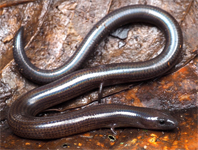Abstract
The recent report of Nemoura lacustris Pictet, 1865 in Great Britain has raised doubts on its identity, given the isolation with respect to the Mediterranean and continental populations of this species. Using molecular analyses, we tested if populations from the United Kingdom and the Iberian Peninsula were conspecific and tested the hypotheses of a recent colonization event versus a more ancient origin for the British populations. Phylogenetic analysis of the mitochondrial marker COI allowed us to conclude that the United Kingdom specimens morphologically ascribed to N. lacustris were conspecific with populations from France and the Iberian Peninsula. Based on the genetic divergence of the two reciprocally monophyletic clades from the Iberian Peninsula and Great Britain/France, respectively, the present distribution of N. lacustris can be postulated as a relatively recent dispersal or introduction into Great Britain from France.
Finally, we note the isolated position displayed by N. lacustris in the phylogenetic tree of Nemoura species based on COI sequences, as the sister to all included species of the genus. This isolated position corresponds with the specific morphology of N. lacustris genitalia and requires additional studies to ascertain clearer generic boundaries within the Nemouridae.-
References
Armitage, P.D. & Bass, J.A.B. (2013) Long-term resilience and short-term vulnerability of South Winterbourne macroinvertebrates. Proceedings of the Dorset Natural History and Archaeological Society, 134, 43–55.
Aubert, J. (1960) Contribution à l’étude des Plécoptères du Maroc. 1960. Mitteilungen der Schweizerischen entomologischen Gesellschaft, 33 (4), 213–222.
Coles, B.J. (2000) Doggerland: the cultural dynamics of a shifting coastline. In: Pye, K. & Allen, S.R.L. (Eds.), Coastal and Estuarine Environments: Sedimentology, Geomorphology and Geoarchaeology. Geological Society Special Publication No. 175. The Geological Society, London, pp. 393–401.
https://doi.org/10.1144/GSL.SP.2000.175.01.27
Baumann, R.W. (1975) Revision of the stonefly family Nemouridae (Plecoptera): a study of the world fauna at the generic level. Smithsonian Contributions to Zoology, 211, 1–74.
https://doi.org/10.5479/si.00810282.211
Despax, R. (1951) Plécoptères. Faune de France, vol. 55. Paul Lechevalier. Paris, 280 pp.
DeWalt, R.E., Maehr, M.D., Neu-Becker, U. & Stueber, G. (2018) Plecoptera Species File Online. Version 5.0/5.0. Available from: http://Plecoptera.SpeciesFile.org (accessed 10 December 2018)
Errochdi, S., El Alami, M., Vinçon, G., Abdaoui, A. & Ghamizi, M. (2014) Contribution to the knowledge of Moroccan and Maghrebin stoneflies (Plecoptera). Zootaxa, 3838 (1), 46–76.
https://doi.org/10.11646/zootaxa.3838.1.2
Fochetti, R., Sezzi, E., Tierno de Figueroa, J.M., Modica, M.V. & Oliverio, M. (2009) Molecular systematics and biogeography of the western Mediterranean stonefly genus Tyrrhenoleuctra (Plecoptera, Insecta). Journal Zoological Systematics Evolutionary Research, 47 (4), 328–336.
https://doi.org/10.1111/j.1439-0469.2008.00508.x
Fochetti,R., Gaetani, B., Fenoglio, S., Bo, T., López-Rodríguez, M.J. & Tierno de Figueroa, J.M. (2011) Systematics and biogeography of the genus Besdolus Ricker, 1952: molecules do not match morphology (Insecta, Plecoptera). Zootaxa, 3067, 49–58.
https://doi.org/10.11646/zootaxa.3067.1.4
Folmer, O., Black, M., Hoeh, W., Lutz, R. & Vrijenhoek, R. (1994) DNA primers for amplification of mitochondrial cytochrome c oxidase subunit I from diverse metazoan invertebrates. Molecular Marine Biology Biotechnology, 3, 294–299.
Hammett, M.J. (2012) Nemoura lacustris Pictet, 1865 (Plecoptera: Nemouridae) - an addition to the British list. Entomologist’s monthly magazine, 148 (1772), 43–45.
Hasegawa, M., Kishino, H. & Yano, T. (1985) Dating of the human-ape splitting by a molecular clock of mitochondrial DNA. Journal Molecular Evolution, 22 (2), 160–174.
https://doi.org/10.1007/BF02101694
Lanfear, R., Frandsen, P.B., Wright, A.M., Senfeld, T. & Calcott, B. (2017) PartitionFinder 2: new methods for selecting partitioned models of evolution for molecular and morphological phylogenetic analyses. Molecular Biology and Evolution, 34 (4), 1016–1020.
https://doi.org/10.1093/molbev/msw260
Le Doaré, J. & Vinçon, G. (2006) Les Plecoptères de France: inventaire des espèces signalées par départements (Plecoptera). Ephemera, 7 (1), 11–43. [2005]
Miller, M.A., Pfeiffer, W. & Schwartz, T. (2010) Creating the CIPRES Science Gateway for inference of large phylogenetic trees. Proceedings of the Gateway Computing Environments Workshop (GCE), 14 Nov. 2010, pp. 1–8. [New Orleans, Louisiana]
https://doi.org/10.1109/GCE.2010.5676129
Nguyen, L.-T., Schmidt, H.A., von Haeseler, A. & Minh, B.Q. (2015) IQ-TREE: A fast and effective stochastic algorithm for estimating maximum likelihood phylogenies. Molecular Biology and Evolution, 32, 268–274. https://doi.org/10.1093/molbev/msu300
Oliverio, M. & Mariottini, P. (2001) A molecular framework for the phylogeny of Coralliophila and related muricoids. Journal of Molluscan Studies, 67 (2), 215–224.
https://doi.org/10.1093/mollus/67.2.215
OPIE-BENTHOS (Office Pour les Insectes et leur Environment) (2018) Plecopteres. Atlas de distributon des especes. Available from: http://www.opie-benthos.fr/opie/insecte.php (accessed 9 October 2018)
Pictet, A.E. (1865). Synopsis des Névroptères d’Espagne. J. B. Baillières et fils – F. Savy. Géneve, 123 + 14 pp.
Puillandre, N., Lambert, A., Brouillet, S. & Achaz, G. (2012) ABGD automatic barcode gap discovery for primary species delimitation. Molecular Ecology, 21, 1864–1877.
https://doi.org/10.1111/j.1365-294X.2011.05239.x
Ronquist, F., Teslenko, M., Van Der Mark, P., Ayres, D.L., Darling, A., Höhna, S., Larget, B., Liu, L., Suchard, M.A., & Huelsenbeck, J.P. (2012) MrBayes 3.2: efficient Bayesian phylogenetic inference and model choice across a large model space. Systematic biology, 61 (3), 539–542.
https://doi.org/10.1093/sysbio/sys029
Tapia, G., Bass, J.A.B. & House, A. (2018) Further occurrence records for the Winterbourne Stonefly Nemoura lacustris Pictet, 1865, (Plecoptera: Nemouridae). Entomologist’s Monthly Magazine, 154, 60–64.
https://doi.org/10.31184/M00138908.1541.3915
Tierno de Figueroa, J.M., Sánchez-Ortega, A., Membiela-Iglesia, P. & Luzón-Ortega, J.M. (2003) Plecoptera. In: Ramos, M.A. Alba-Tercedor, J., Bellés, X., Gosálbez, J., Guerra, A., MacPherson, E., Serrano, J. & Templado, J. (eds), Fauna Ibérica, vol. 22. Museo Nacional de Ciencias Naturales. CSIC. Madrid, 1–404 pp.
Tierno De Figueroa, J.M., Gaetani, B, Luzón-Ortega, J.M., López-Rodríguez, M.J. & Fochetti, R. (2011) On the identity of Isoperla curtata (Plecoptera: Perlodidae): behavioural and molecular approaches show the existence of two separate species. Zootaxa, 3000, 49–58.
https://doi.org/10.11646/zootaxa.3000.1.3
Tierno de Figueroa, J.M., Luzón Ortega, J.M. & López Rodríguez, M.J. (2017) Species Nemoura lacustris. Pictet, 1865. In: IBERFAUNA. El Banco de Datos de la Fauna Ibérica. Museo Nacional de Ciencias Naturales (CSIC). Available from: http://iberfauna.mncn.csic.es/showficha.aspx?rank=T&idtax=13504 (accessed 9 October 2018)

